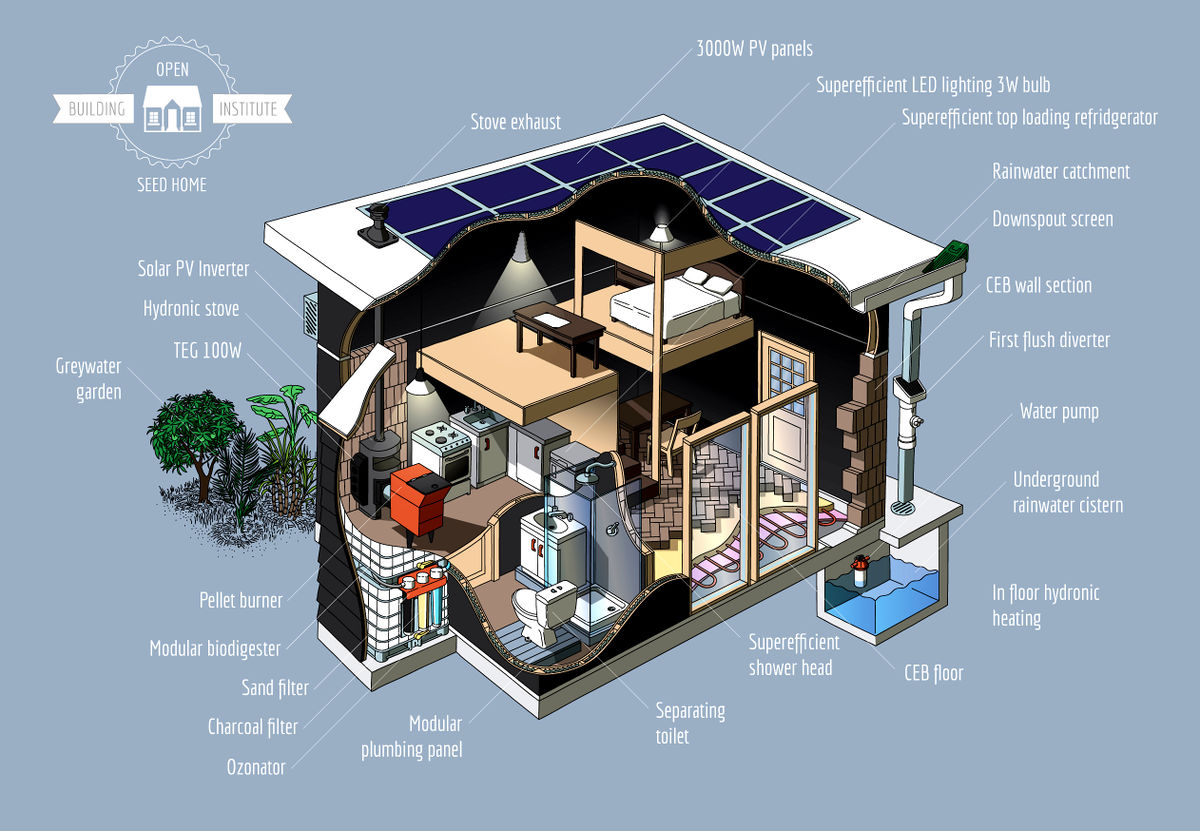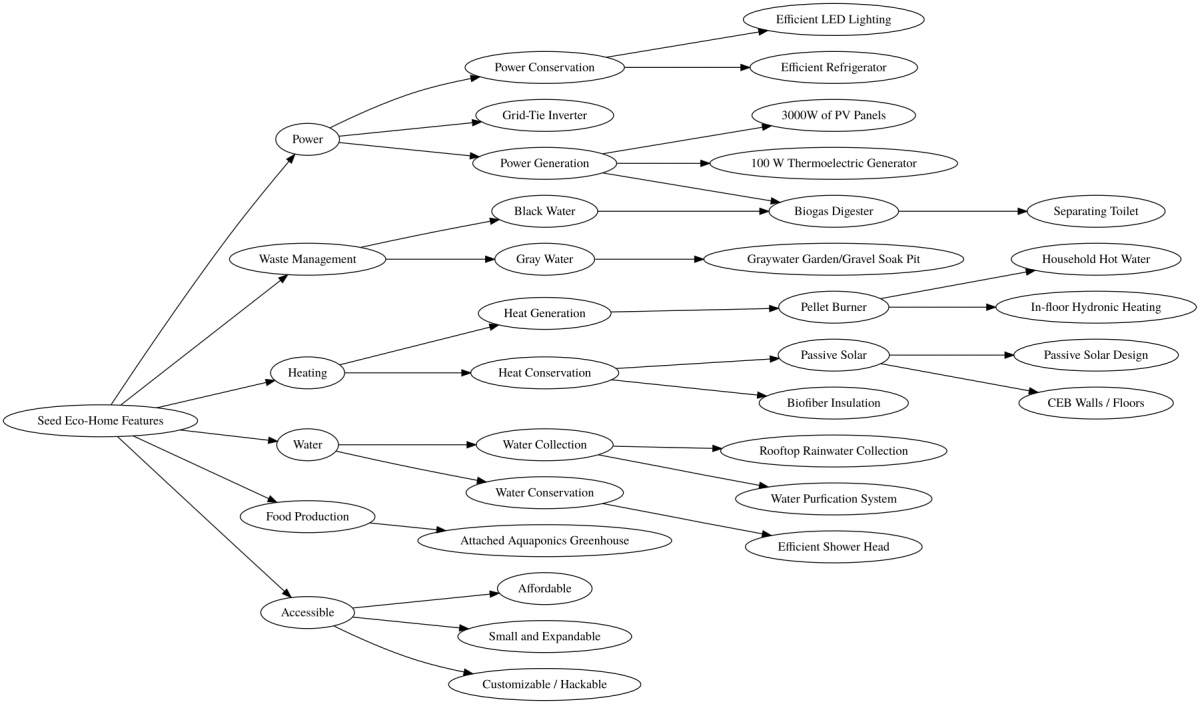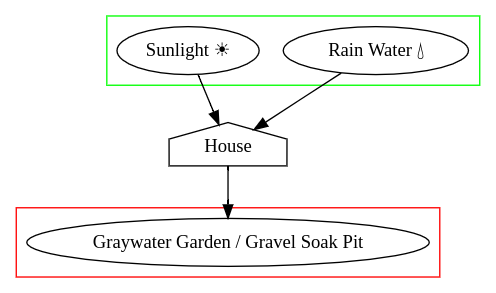Seed Eco-Home Features 2016
![]() Hint: These are the eco features built or planned for the 2016 Seed Eco-Home build. For the 2022 model, see Seed Eco-Home Eco Features 2022
Hint: These are the eco features built or planned for the 2016 Seed Eco-Home build. For the 2022 model, see Seed Eco-Home Eco Features 2022
Infographic
Open Building Institute Introduction
Seed Home and Expandable Starter Home
Product Narrative for the November 2016 Expandable Starter Home Prototype
The Expandable Starter Home is a 700 square foot (sf) structure consisting of a core utility module with additional space.
Here we show a 16'x20' Seed Home model, which is what a self-contained microhouse version of the Expandable Starter Home would look like:
Download this model in SweetHome 3D - [1]
All the utilities can fit in as little as a 16'x16' core utility module. The bill of materials cost for the 700 sf structure including foundation starting from graded land is under $25k.
Features List -> Future Features List
- 3000W PV -> 3000W Open Source PV
- Biogas Digester
- Grid-Tie Inverter -> Open Source Hydbrid (on-grid/off-grid) Inverter
- Open Source Thermoelectric Generator
- Superefficient LED Lights (3W Each)
- Superefficient Refrigerator (8W average)
- Pellet Burner for House and Water Heating
- In-Floor Hydronic Heating
- CEB Floor
- 2 CEB Wall Modules
- Modular Plumbing Fixtures
- Modular electric panel
- Passive Solar Design
- Biofiber Insulation
- Rainwater Collection
- Superefficient Shower Head
- Water purification: sand, charcoal, ozonator
- Separating Toilet
- Soak Pit
For data collection, we will have open source data logging for power usage, temperature, and humidity.
Features Narrative
The Expandable Starter Home is full of advanced eco-features that come in the standard model. With 3000W of PV Panels, the house is completely self-sufficient on energy. It makes no sense for any new construction to build without PV panels - see Feasibility Notes on PV).
What happens when the sun doesn't shine? The standard feature is a grid-tie inverter, which also pushes power back to the grid in the day. Feasibility Notes on Grid Tie Inverter
What about power generation at night? A 100 W Thermoelectric Generator (TEG) is included. This device converts heat into electricity, so you can be generating power from your pellet stove. We are designing our pellet heating stove to function both as a space heater and power generator. With Superefficient LED Lighting (3W per bulb), and a Super-efficient Refrigerator that uses only 8W of power - that is plenty of power to run your computer and house if you are eco-conscious. The See notes on the Feasibility of TEG Power.
The modular hydronic stove features a Pellet Burner integrated with heat exchangers for a Hydronic Heating System. This heating system provides both Household Hot Water, and hot water for the In-floor Hydronic Heating. Floor heat is a luxurious comfort - and from our experience, we would not do anything else after seeing how well the system works - while being straightforward to install when open source plans are avaialable. We have decided that in-floor heating is a standard feature in all of our construction, and have experience with hydronics both in our house and for heating ponds in the aquaponic greenhouse. See Feasibility of a Pellet Hydronic Stove.
The floor itself is a Compressed Earth Block (CEB) Floor, finished and stone sealed for a luxurious look. In addition to transferring heat from in-ground hydronics, it also works in a passive solar heating capacity when light from two large windows enters in the winter. We are also including CEB Walls. An 8x8 foot wall section made of CEBs serves as thermal mass and solid 6000 lb structure. The thermal mass of CEBs is effective in keeping the house cooler in summer, and it retains heat longer in winter. The CEBs and solar capture contribute to the house's Passive Solar Design - which also includes passive cross-ventillation through the house. Open source Bio-fiber Insulation obtained from biomass or waste paper streams will be used in the wall cavities to get insulation values of 20 for the walls and 40 for the roof as our standard feature.
To continue the eco features, we are also doing Rooftop Rainwater Collection, where every inch of water provides 150 gallons of rainwater for a 16'x16' roof. This provides 450 gallons per inch of rainfall over a 675 square foot home model. We are also using a Super Efficient Shower Head by Bricor, for 3/4 gallon per minute water usage. The shower itself features an easy-to-install modular shower wall, and a cast concrete base. Just like with the sink module, we are using Modular Plumbing Panels. These are essentially your standard utility - like a sink, shower, or toilet - except built on a self-contained pedestal - which contains plumbing. The modular plumbing panels have a simple quick connectors for water in and water out - and as such - can be build as modules and put into place readily - without having to do the entire plumbing finishing as a later step.
To purify the water, we are using a filtration system consisting of a Sand Filter, a Charcoal Filter, and the world's first open source Ozonator as the final disinfectant stage for potable water, instead of halogens like chlorine. 90% of the world's purified water is obtained by ozonation, so we'd like to bring the USA up to speed in this respect. The design also calls for a small pond, used for irrigation or or to supplement rainwater collection.
The wastewater system converts organic wastes into biogas using a home scale Biogas Digester. This provides 100% of the house cooking gas, using a cooktop. We are using a separating flush toilet, where the solids flow into the biodigester, and the liquids and other graywater go into a Graywater Garden/Gravel Soak Pit. A sink grinder pulverizes organic wastes for quicker digestion.
Now if any of these features don't suit your situation for whatever reason - you can replace them with more mainstream options. Our design is highly modular, where attention to interface design results in easy substitution of parts. Further, this house functions like a seed home - where additions can be built as resources allow.
Aquaponic Greenhouse
An attached greenhouse is designed to provide heat in the winter and food year round. By combining aquaponics (plants and fish), chickens, vermiculture, mushroom culture, duckweed and azolla, we are creating a year-round food growing system that can provide a large portion of one's diet from vegetables, fish, and chicken eggs. The ponds are heated with hydronics from the household heating system. Efficient use of vertical space is obtained with vertical growing towers, mushroom towers, and worm towers. Worms, duckweed, azolla, and food scraps are used to feed the chickens and fish. See more info at Aquaponic Greenhouse Workshop.
Hydroponics Instead Of Aquaponics
If we replace keeping animals (aquaponics, vermiculture, chickens) with hydroponics and the already existing waste management system we get the following benefits:
- ethically: no intentional breeding, suffering and killing built into the home design.
- sustainability: much lower emissions, much lower energy use, reduced waste production, produce keeps longer and stores better.
- simplicity: easier to understand what is going on
- efficiency: removing animals and these components from the loop makes the loop smaller and more efficient, in general but specifically energy efficient due to removing trophic layers.
- time-efficiency: no need for constant monitoring and tweaking
- re-use of existing modules: integrate with and extend the existing waste management system
- reliability: a smaller, simpler loop means there are less things that can go wrong
- productivity: make better use of the space and increase productivity by accommodating the plants more for example by using a Heat Recovery Ventilator to keep the inside air nice and fresh while climate controlled. We can use much smaller tanks for things like Duckweed, Chlorella, Spirulina. Much more nutrients and calories for less and fewer inputs (time, energy, resources, labor, capital)
- affordability: less and fewer input (time, energy, resources, labor, capital) required for sustainable higher productivity
- maintainability: much simpler to troubleshoot and maintain, requiring much less maintenance overall.
Feature Summary Tree Diagram
Generated from following .dot or .gv file:
.dot / .gv file contents
digraph "Seed Eco-Home Features" {
rankdir="LR"
"Seed Eco-Home Features" -> "Power"
"Seed Eco-Home Features" -> "Waste Management"
"Seed Eco-Home Features" -> "Heating"
"Seed Eco-Home Features" -> "Water"
"Seed Eco-Home Features" -> "Food Production"
"Seed Eco-Home Features" -> "Accessible"
"Power" -> "Power Conservation"
"Power" -> "Grid-Tie Inverter"
"Power Conservation" -> "Efficient LED Lighting"
"Power Conservation" -> "Efficient Refrigerator"
"Power" -> "Power Generation"
"Power Generation" -> "3000W of PV Panels"
"Power Generation" -> "Biogas Digester"
"Power Generation" -> "100 W Thermoelectric Generator"
"Waste Management" -> "Gray Water" -> "Graywater Garden/Gravel Soak Pit"
"Waste Management" -> "Black Water" -> "Biogas Digester" -> "Separating Toilet"
"Heating" -> "Heat Generation"
"Heating" -> "Heat Conservation"
"Heat Generation" -> "Pellet Burner"
"Pellet Burner" -> "Household Hot Water"
"Pellet Burner" -> "In-floor Hydronic Heating"
"Heat Conservation" -> "Passive Solar"
"Passive Solar" -> "Passive Solar Design"
"Passive Solar" -> "CEB Walls / Floors"
"Heat Conservation" -> "Biofiber Insulation"
"Water" -> "Water Collection"
"Water" -> "Water Conservation"
"Water Collection" -> "Rooftop Rainwater Collection"
"Water Collection" -> "Water Purfication System"
"Water Conservation" -> "Efficient Shower Head"
"Food Production" -> "Attached Aquaponics Greenhouse"
"Accessible" -> "Affordable"
"Accessible" -> "Small and Expandable"
"Accessible" -> "Customizable / Hackable"
}
Input & Output
Generated from following .dot or .gv file:
.dot / .gv file contents
digraph House {
subgraph cluster_inputs {
color=green
"Rain Water 💧"
"Sunlight ☀" [fillcolor=red]
}
subgraph cluster_house {
node [shape=house]
"House"
color=white
}
"Rain Water 💧" -> "House"
"Sunlight ☀" -> "House";
"House" -> "Graywater Garden / Gravel Soak Pit"
subgraph cluster_outputs {
color=red
"Graywater Garden / Gravel Soak Pit"
}
}
Future Developments
After the November 2016 build, we will work on incorporating open source silicate mineral paint, local concrete, 3D printed multi-wall glazing panels, and local lumber. We will develop a 16 kW vertical axis wind turbine, and integrate urine in a nutrient cycle with the greenhouse that gives us the capacity for a closed loop water system. We will also work on solar hydrogen storage for night time power, and possibly compressed air storage pending feasibility study.
Links
- Universal Design is Architecture for All - [2]
- The Universal Design Living Laboratory (UDLL), a modern prairie-style house completed in November 2012, is a National Demonstration Home in Columbus, Ohio. - [3]
- Universal Design of Physical Spaces - [4]
- The Right Space - [5]
- Barrier free design - [6]
- The Center for Universal Design - [7]
- Integrative design for radical energy efficiency | Amory Lovins - [8]
- Lovins GreenHome 1.0 Factor Ten Engineering Case Study - [9]


